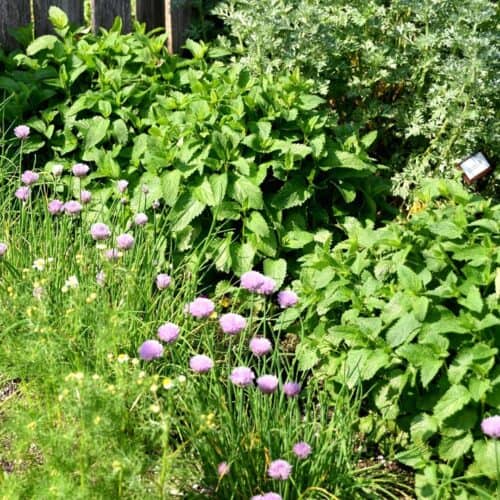How to Start an Organic Garden can be intimidating if you are a beginner.
What you should know is that organic gardening is popular because it is done without using products that may contain harmful chemicals that can harm the environment, wildlife, and human health.

Starting an organic garden for beginners.
Planning an organic garden is similar to planning most any other garden.
What makes organic gardening different from regular gardening is using organic seeds and plants and avoiding synthetic pesticides and fertilizers.
Did you read about How to Start a Vegetable Garden for Beginners?
Starting a vegetable garden has many of the same steps as starting an organic garden.
Both this organic gardening guide and that vegetable garden guide may be helpful in planning your new garden.
There are plenty of great products to help you with your organic gardening. You can find helpful organic gardening tools and ideas here.
Frequently asked questions about organic gardening.
The term 'organic gardening' refers to a garden that is grown without the use of synthetic pesticides, herbicides, or fertilizers.
Organically grown gardens rely upon natural methods of pest control and soil enrichment, such as composting, crop rotation, and companion planting. Organic gardening also emphasizes the use of natural and sustainable gardening practices that promote soil health and biodiversity.
In a nutshell, people garden organically to prevent the harmful effects that can be related to gardening. They also feel that food grown organically is healthier as a result.
IA regular garden may use synthetic pesticides, herbicides, and fertilizers to control pests and promote plant growth. These products can contain harmful chemicals that can harm the environment, wildlife, and human health.

What are the differences between organic and regular gardening?
Organic gardening is a more sustainable and environmentally friendly approach to gardening because it promotes healthy soil, plants, and ecosystems. This is done through soil health, pest control, and fertilizing.
Organic gardening is also helpful for Biodiversity.
That is, organic gardening promotes biodiversity by encouraging the use of natural habitats that may also be beneficial to insects and wildlife. In contrast, regular gardening may use planting and chemical products that can harm the environment and reduce biodiversity.
How do you start an organic garden?
Before you get started with your garden, you can plan out the steps needed to get your garden started and growing. Before you know it, you may be harvesting what you grow.
- Choose a location for your organic garden.
- Prepare the soil.
- Select the plants
- Planting
- Organic Mulching
- Taking care of the plants Organic Fertilizing.
- Natural Pest control
How to choose a location for an organic garden.
When selecting a location for your organic garden, for best results, choose a location that has the best chance of getting the ideal amount of natural sunlight needed. Soil and drainage are also important but, can be somewhat altered to your needs.
Here is what else you should keep in mind when selecting a location for your organic garden.
- While most vegetables need at least five to six hours of direct sunlight per day, there are some varieties( Brussels Sprouts, carrots, and radishes for example) that are okay with partial sunlight.
- Drainage is important as you do not want your vegetables to be under water. You can make your gardening life easier when it rains a lot if you select a location that has its own natural drainage.
- Before you start digging, notify your local utilities or local folks who need to know about digging. In many locations they will need to come out and mark the area so you do not dig up something vital...like your cables.
- Testing the PH of your soil will give you a 'heads up' on needs such as fertilizers.
How to prepare the soil for an organic garden.
Sometimes soil can be a huge factor in the success of a plant. This is because the soil may the hard, have a lot of unknown materials, sand or clay in it, or simply be hard to work with.
Prepare the Garden Soil for Planting
- Consider replacing the soil with good garden soil.
- Loosen up the soil by tilling or turning it.
- Mix in organic matter or compost to give your plants a head start.
Loosen the soil and remove any weeds, rocks or debris. Add compost, aged manure or other organic matter to enrich the soil. Mix well and level the ground.
As mentioned, organic gardening emphasizes the importance of soil health and biodiversity. This means that organic gardens rely on natural methods of soil enrichment, such as composting, cover cropping, and crop rotation. This helps to promote healthy soil that is rich in nutrients and beneficial microorganisms.
👇You may also be interested in these ideas!👇
👉Be sure to follow us on Facebook, Pinterest, and Instagram.
Subscribe to our Weekly Newsletter.
How to select plants for an organic garden.
Organic vegetable plants can be grown from seeds or from plants that have already been started.
It may be a good idea to start a new organic garden with plants that are already started as seeds take a while to grow to a planting size.
What to keep in mind when you purchase plants for your organic garden.
- Do your research to see what grows best in your area. Talk to the pros at your local gardening store or university extension if needed.
- What you may not know is that the same plant distributor may distribute to more than one store or garden center in your location. However, going to a store or garden center that takes good care of the plants they sell or offers a warranty, can ensure that you are getting a good plant.
- If the plants do not look so great when you go to purchase them, find out when the shipments of fresh plants come in so you can get a better selection of new plants. In my area the new plants are delivered on thursdays or fridays for the weekend shoppers.
- Lastly, read the labels or descriptions on the plants to see if they have been started in an organic environment.
How to plant your plants in an organic garden .
You have done your research, prepped your garden, and purchased the plants. Now it is time to plant!
Start by reading the label or card that came with the plants.
- The label will tell you how deep to plant the vegetable plants and how much spacing the plants should have between them.
- Try to group plants with similar watering and light needs if possible.
- Many plants, such as smaller tomatoes, can do well when planted in a large planter. I will plant larger tomatoes, such as beefstakes, in the ground and smaller tomatoes, such as cherry, in a planter on my patio.
- After planting the plants, you can add mulch and water them as needed.
Watering plants in an organic garden.
Keeping your plants properly hydrated is important is especially true when it is hot and dry out. It is best to water early in the day and to avoid getting the leaves wet if possible. Plants need about an inch an a half of water a week during normal conditions.
Watering is essential for the health of your vegetable garden.
Depending on the weather and soil conditions, it may need more or less water than usual. When watering, try to use a slow, steady stream of water over the surface of your soil, but also to directly target individual plants or groups.

Organic Garden Mulching
Mulching is applying a layer of matter over the soil around a plant that you have planted. This is done to prevent weed growth, can keep the plants more temperature regulated, help keep the moisture in the soil, and lastly, mulching helps to protect the soil.
Using natural material for mulching in an organic garden is preferred.
Apply your mulch around the base of your plants, leaving space for water to get to the plants for nourishment. You can do this with organic materials such as dried leaves, straw, or grass clippings. Make sure that these organic materials have not been treated with harmful products and are disease-free.
Fertilizing organic plants.
Plants can benefit from fertilizing so read the labels or do your research to see how your plants can benefit. Fertilizing will help ensure that your plants receive the nutrients they may need for growth and food production or blooming.
What makes organic gardening different is that it uses natural sources of fertilizer to provide nutrients to plants.
Natural sources of fertilizer include compost, manure, or bone meal . In contrast, regular gardening may use synthetic fertilizers that can harm the environment and contribute to soil degradation.
Fertilize your organic garden using compost. Compost is made from organic matter such as food scraps, leaves, and grass clippings.

Pest Control in an organic garden.
Garden pests can be insects or animals. Organic gardening uses natural methods to control pests rather than methods that may be harmful to the environment. The most popular method for pest control can be fencing around the garden and attracting beneficial insects.
There are other natural methods for controlling pests in an organic garden.
Learn about companion planting, using organic pest control products like neem oil or soap sprays. In contrast, regular gardening may rely on synthetic pesticides and herbicides to control pests. Avoid using synthetic pesticides and herbicides to keep your garden organic.
Try using natural pest control methods like companion planting, which involves planting certain plants together that repel pests or attract beneficial insects.
Planting marigolds around your tomatoes can help repel rabbits. On the other hand, planting herbs like basil and parsley, can attract beneficial insects like ladybugs that eat aphids and other pests.

Easy plants for an organic garden.
1. Tomatoes
It could be the popularity and the versatility of uses that makes tomatoes an ideal fruit to grow. Tomatoes like warm weather and sun. They will also need some kind of support, such as tomato cages, while they grow. While tomatoes will grow in most kinds of soil they do prefer a soil ph of 5.8 to 7.0 and occasional fertilizing.
2.Carrots.
Carrots are relatively low maintenance vegetables that need full sun and well-drained soil with some compost. When planting carrots, it is best to plant them in rows. The most important factor to consider when planting carrots is that the soil needs to be loose enough got the carrots to grow in (adding a bit of sand can help). Carrots grow well in raised beds too.
3. Peas.
Peas are a fast-growing vegetable that require full sun. Unlike with other vegetables, peas like cool weather which means that you can plant the seeds in your garden when the soil temperature reaches 45 degrees. You can speed up the germinating process of pea seeds by actually soaking them in water overnight.
4. Bell peppers.
You probably already know that bell peppers come in a variety of sizes, shapes, and colors. Bell peppers are actually a fruit. They are easy to grow with thanks to a hort two-month season. Plant your bell peppers in moist soil and provide six to eight hours of sunlight per day. Some varieties of peppers may need to be staked or caged for support as the plants can get heavy when full of peppers.
5. Radishes
Radishes are ideal for beginning gardeners as they are small and they also grow fast. They can also be planted in the spring and the fall seasons. These vegetables can enjoy partial shade (sun about four to six hours depending on the heat). Radishes are another good candidate for patio container planting.
6. Cucumbers.
Cucumbers are a fruit that grows on vines. It is a good idea to use a trellis that your cucumbers can grow on. Cucumbers do need space, especially vertical, to grow. They should be planted behind smaller plants as they can block sunlight as they grow.
7. Green onions
Green onions, I will add chives here because they grow and can be used similarly, are incredibly easy and fast . You can actually grow green onion indoors or outdoors. Read about How to Grow Onions Indoors here . Outdoor planting for onions is relatively simple as they do not need a lot of space and like most soils.
8 Leafy Greens
Leafy greens: Lettuce, spinach, kale, and other leafy greens are easy to grow and provide a continuous supply of nutritious greens. They prefer cooler temperatures and partial shade.
9 Beans
Beans: Beans are versatile and easy to grow. They come in bush and climbing varieties and prefer warm and sunny conditions. They also help to fix nitrogen in the soil.
10 Herbs
Herbs like basil, thyme, parsley, and mint are essential for adding flavor to your dishes. They grow well in containers or in the ground and need full sun and well-draining soil.
👇👇Related Ideas.👇👇
In case you missed it.
- Starting an organic garden for beginners.
- Frequently asked questions about organic gardening.
- What are the differences between organic and regular gardening?
- How do you start an organic garden?
- How to choose a location for an organic garden.
- How to prepare the soil for an organic garden.
- How to select plants for an organic garden.
- How to plant your plants in an organic garden .
- Watering plants in an organic garden.
- Organic Garden Mulching
- Fertilizing organic plants.
- Pest Control in an organic garden.
- Easy plants for an organic garden.
How to Start an Organic Garden, a beginners guide to preparing soil, choosing plants, and caring for plants in an organic garden.

Thanks so much for visiting!
If you decide to try any of the ideas listed in this article please tag on social media @diyandfun. We like to hear your ideas and suggestions.
DIY and Fun is a website dedicated to providing you with the best DIY projects, crafts, recipes, hiking, and fun ideas that inspire. Whether you're looking for a new way to decorate your home, learn a new skill, or simply have some fun, DIY and Fun has something for everyone.
Here are some additional ways to keep coming back to DIY and Fun:
- Sign up for our email newsletter. We'll send you weekly updates with new projects, inspiration, and more.
- Follow us on social media. We're on Facebook, Twitter, and Pinterest.
- Our community forum is coming soon. Share your projects, ask questions, and get inspired by other DIYers.











